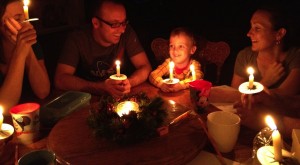Let’s continue relating the familiar objects of Christmas to the coming of our Savior!

In 16th-century Germany fir trees were decorated, both indoors and out, with apples, roses, gilded candies, and colored paper. In a popular religious play in the Middle Ages about Adam and Eve’s expulsion from the Garden, a fir tree was decorated with apples and used to symbolize the Garden of Eden, the Paradise Tree. The play ended with the prophecy of a savior coming, and so was often performed during the Advent season.
It is held that Protestant reformer Martin Luther first adorned trees with light. One December evening, the beauty of the stars shining through the branches of a fir tree inspired him to recreate the effect by placing candles on the branches of a small fir tree inside his home.
The Christmas Tree was brought to England by Queen Victoria’s husband, Prince Albert from his native Germany. The famous Illustrated News etching in 1848, featuring the Royal Family gathered around a Christmas tree in Windsor Castle, popularized the tree throughout Victorian England. The Christmas tree was brought to America by the Pennsylvania Germans and became popular by the late 19th century.
So how do we transform this to make it a reminder of the birth of Jesus Christ?
When putting up your tree, remember the Tree in the Garden of Eden and the sin that took place there. This brought about the need for a Savior to be born.
The fact that the fir tree is an evergreen can remind us of our Savior’s everlasting love for us.
When you look at your decorated tree, remember God did His best work on a tree when He gave His Son to die on a Cross for all of us!
A very good children’s book related to how God used trees in Christ’s life is The Tale of Three Trees: A Traditional Folktale by Angela Elwell Hunt.



